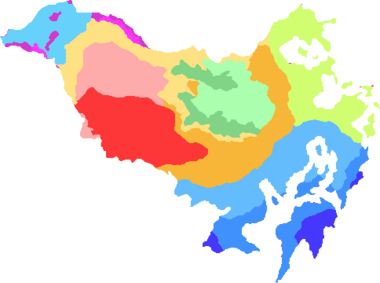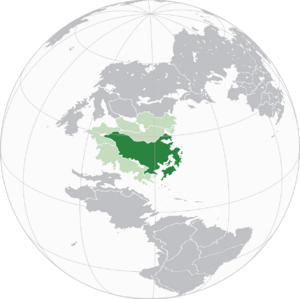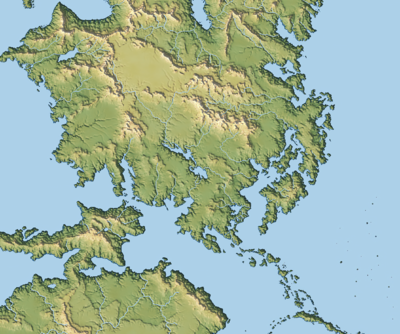Federated Fire Territories: Difference between revisions
Deskjetser (talk | contribs) mNo edit summary |
Deskjetser (talk | contribs) mNo edit summary |
||
| Line 10: | Line 10: | ||
|motto = “Eftārīsan fram þās ahse.”<br>"Rise again from these ashes." | |motto = “Eftārīsan fram þās ahse.”<br>"Rise again from these ashes." | ||
|national_anthem = | |national_anthem = | ||
|image_map = septFyrlandGlobe3.png | |image_map = {{Switcher|[[File:septFyrlandGlobe3.png|frameless]]|Show globe|[[File:Sept Fyrland Globe Projection.png.png|upright=1.15|frameless]]|Show map of Lower-Vinya}} | ||
|map_width = 275px | |map_width = 275px | ||
|map_caption = {{legend|#2B8340|''Fȳrēþel''}} & {{legend|#C6DCBE|''Erecg-Wīnya''}} | |map_caption = {{legend|#2B8340|''Fȳrēþel''}} & {{legend|#C6DCBE|''Erecg-Wīnya''}} | ||
Revision as of 20:51, 31 March 2020
This article is incomplete because it is pending further input from participants, or it is a work-in-progress by one author. Please comment on this article's talk page to share your input, comments and questions. Note: To contribute to this article, you may need to seek help from the author(s) of this page. |
Federation of Fire Territories Fērlæcende Fȳrēþel | |
|---|---|
|
Flag | |
| Motto: “Eftārīsan fram þās ahse.” "Rise again from these ashes." | |
Fȳrēþel & Erecg-Wīnya | |
| Capital | Nīwe-Fȳrhēafodstōl |
| Largest city | Brēcænburg |
| Official languages | Fēþisc; Isætinyan |
| Recognised regional languages | Īweric |
| Ethnic groups | 76% Fȳrfolc 16% Bēnirani 5% Īweri 3% Other |
| Demonym(s) | Fȳrfolc |
| Government | Federal Constitutional Monarchy |
• Monarch | Æþelric XIII |
| Establishment | |
• Dǣd Gēmunglic be Fȳr (Lit: Nuptial Deed in Fire) | 1001 |
• Forma Dōþ of Annes (Lit: First Acts of Union) | 1203 |
• Ōðer Dōþ of Annes (Lit: Second Acts of Union) | 1487 |
| Area | |
• Total | 3,808,180.22 km2 (1,470,346.60 sq mi) |
| Population | |
• 2018 census | 277,467,426 |
• Density | 72.86/km2 (188.7/sq mi) |
| GDP (PPP) | estimate |
• Total | $6,496.11 billion |
• Per capita | $22,830 |
| GDP (nominal) | estimate |
• Total | $4,925.03 billion |
• Per capita | $17,750 |
| HDI (2018) | 0.804 very high |
| Currency | Fȳrpund (FTP; Ꞩ) |
| Date format | dd/mm/yyyy |
| Driving side | right |
| Internet TLD | .fyr |
The Fire Territories, officially the Federation of Fire Territories but more commonly known as Fyrland, is a sovereign country on the continent of lower Vinya, on Septentrion. It is bordered by Tír Ealga to the north, Bēnirani in the south, Crioch Fuinidh and Tīri-Ēra in the west.
Fȳrēþel is a federal parliamentary democracy and constitutional monarchy. The current monarch is Æþelric XIII, who has reigned since 2005. Fȳrēþel's capital city is Nīwe-Fȳrhēafodstōl, but not its largest; Its largest city is Brēcænburg, a global city and industrial centre with a population of 13.5 million. The Greater Brecanburg area (Fēþisc: Swīþlic Brēcænburgsetl) is the most populous metropolitan area in the world with over 40 million people. Other major urban areas in Fȳrēþel include Fæstēah, Nīwe-Fȳrhēafodstōl, Clorēþsted, Adlertūn and Hātaþurg.
Fȳrēþel is a developed country and has the world's fourth-largest economy by nominal GDP and fourth-largest economy by purchasing power parity. It has a middle-income economy and has a high Human Development Index rating.
Etymology
Prior to 1203 the 18 kingdoms under the Fire-Empire (Fēþisc: Ᵹiſæti-Isæti) monarchy were formally known as the Fȳrcynerīce; Colloquially known as the "Fire Kingdom". This name would stand until 1203.
The 1203 First Acts of Union (Fēþisc: Forma Dōþ of Annes) declared that the then 21 kingdoms of Lower-Vinya (Fēþisc: Erecg-Wīnya) were "United into One Kingdom under the name of the Fire Territories". The Second Acts of Union (Fēþisc: Ōðer Dōþ of Annes) in 1487 brought the newly purchased island chains of Irēlandes and Geoirēlandes into the union, forming the Fērlæcende Fȳrēþel of Erecg-Wīnya ac Ofersǣþel; Colloquially known as the "Fire Territories", "Fire-land", or "Fyrland".
The adjective "Fȳrisc" (Lit: Fyrish) is commonly used to refer to matters relating to Fȳrēþel. The adjective can also refer to the native Wīnya (Lit: Vinyan) language also referred to as Isætinyan (Lit: Isatinyan); Which can trace its origins to the neighbouring country Bēniran.
The adjective "Fȳrfolc" (Lit: Fire-folk) can be used to refer to several major ethnic groups which make up the modern populous of Fȳrēþel.
In other languages of Septentrion
| Sylvan | Letnian | Anglian | Dayashinese | Shinasthana | Īweric | Serenoran | Jedorian | Katmiesie | Sebrenskiyan | Menghean |
|---|---|---|---|---|---|---|---|---|---|---|
| "Tierra del Fuego" | "Фырулия" "Fyruliya" |
"Fire Territories" | "フィレァンヅ" "Fiyaruandu" |
"飛延" "Pjur-lan" |
"Tír na Tine" | "Teracocodrila" | "Gaisro žemė" | "Vuurland" | "Požariya" | "희르란드" "Hyirŭrandŭ" |
History
See also: History of Lower-Vinya
Background
Settlement by anatomically modern humans of what was to become Fȳrēþel occurred in waves beginning by about 10,000 years ago. By the end of the region's prehistoric period, the population is thought to have belonged, in the main, to a culture termed Insular Niranic, comprising Niranic Bēniran and Pemīmī Tērī-Tēra. The Niranic conquest beginning in 205BCE, and the 800-year rule of Erecg-Wīnya (Lit: Lower-Vinya), was followed by Fēþfolc (Lit: Walking-folk, Ostlandic Eisenmaton traders & settlers), reducing the Niranic area to mainly what was to become Bēniran. Until the later stages of the Fēþfolc settlement, the inner corners of Erecg-Wīnya would remain largely Niranic.
In 1002, the Nīwe-Fȳrfolc (Lit: New-Firefolk) crown and their allies invaded the largely Fēþfolc kingdom of Fieryrþling, after a Nuptial contract named Dǣd Gēmunglic be Fȳr (Lit: Nuptial Deed in Fire) was signed at the marriage of a Norþfȳrdomne to a Sūþfȳrhlǣfdīge (Lit: North-Firelord & South-Firemaiden) in 1001AD. The contract called for the reunification of ancient land rights held by birthright to the family of the Sūþfȳrhlǣfdīge, which had since been heavily permeated by Fēþfolc settlers. This gave rise to the Fȳrcynerīce (Lit: Fire-Kingdom) officially in the year 1001AD.
Geography
The total area of Fȳrēþel is approximately 3,808,180 square kilometres (1,470,346 sq mi). The country occupies the major part of the Lower-Vinyan continent and some smaller islands. Its main coastline lies on the Meridian Ocean, which separates it from the continent of Casaterra.
Ēcefȳr
Ēcefȳr, colloquially Eternal Flames, are a formation of volcanically fuelled fires.
Climate

Fȳrēþel has an extremely varied climate
Economy
17th & early-mid 18th century; 1600-1750
The heavily agrarian economy was the largest employer of the workforce, consisting mostly of serfs known as thralls (Þræl). Making up > 60% of the population, and usually tied to the land they worked through debt bondage. This movement restriction of the workforce meant that relatively few people were responsible for, and benefited from, the work of a large number of Fȳrs.
The coastal regions' primary source of revenue, valuable commodities trade, primarily exchanged with Casaterran trading companies for items of significant monetary value, or sometimes services. Backed by the governments of their respective Casaterran states, these firms wielded tremendous purchasing power, both politically and economically, on the Fȳrish coasts.
Commonly traded commodities were;
- Whale oils; from the northern coasts.
- Lumber; rare and exotic lumbers from the south.
- Furs & skins; furs came from the northern coasts and far north-west, while skins came from all across the country.
- Rice; from the middle and southern interiors.
- Dyes; from all over the country.
- Tobacco; the south coast and tropical areas produced tobacco.
- Sugar; ""
- Molasses; from the refining of sugar.
- Fruits; from the tropical and temperate areas.
- Gold;
- Silver;
- Platinum;
- Rubber; from the rubber trees on the south coasts.
Trade of these commodities brought substantial wealth to Fȳrland. However, wealth concentrated in the elite's hands due to the nature of the underclasses. This elite economic domination allowed the continual system exploitation for a runaway effect. Investment continuously gravitated towards the coastal areas, resulting from the economic arrangement, from which economic power could project mainly from Casaterran sources.
Late 18th & 19th century; 1783-1899
The Thrall reforms seen in the aftermath of the Thrall Uprising largely eliminated the debt bondage system by allowing thralls to work off their debts, effectively giving their work monetary value. These reforms would result in extrication of vast portions of the underclass from the system that confined them to land. Which meant that underclasses now possessed social mobility as well as unprecedented increases in economic purchasing power, through the pursuit of careers rather than obligations. New-found social mobility brought a considerable increase in school enrolment, as well as an explosion in the civic service industry at the turn of the nineteenth century. Both were signalling the birth of the Fȳrish middle class as well as the rise of the working class.
Rapidly amassing purchasing power, the middle and working classes would substitute commodity trading for economic contribution at the end of the nineteenth century, as the economic growth of the coasts continued. The coastal shift from the Casaterranean commodity trade to manufacturing, civic, and intellectual services then took place rapidly; while an ever-increasing influx of workers continued unceasingly. Which maintained drive to improve standards of living, leading to the creation of substantial public works such as roads, sewers, and rail.
Although subtle, coastal revolution correspondingly affected countryside life, as the transport of ever more resources to the coastal industry created intense pressures on the swiftly shrinking agricultural labour force. Major infrastructure works throughout the nineteenth century would ease transport problems and allow even more significant movement of goods and people. However, the biggest concern, production, saw the massive explosion of mechanisation. This mechanisation would fuel further manufacturing demand, as the coast's industrial revolution would further feed the internal drive, ultimately increasing living standards not only for the coast but also for the countryside.
Early 20th century; 1900-1916
By the twentieth century, the middle and working-class were undoubtedly a driving force behind the economy, with huge industries catering to them as well as providing the majority of the workforce. Investing in the economy for the first time, the first consumer-driven investment banks began to appear. The continually decreasing 43% of the workforce engaged in agriculture, now possessed much greater economic and social mobility than 20 years ago. Industries that catered to and employed the middle and working classes continued to raise living standards across the nation as they expanded. Although the coastal regions remained the centres of economic activity throughout this time.
The concentration of the labour force in the affluent coastal cities had given rise to the industrial giants of the early twentieth century, enabled by the supply of educated and skilled workers, excellent infrastructure, and massive capital investment. These super-employers would in-turn continually drive the demand for skilled workers, infrastructure investment, and extend increases to individual purchasing power. At the helm of these industries was a new class of citizen, the self-made tycoons. Self-made elites were a key driver of investment, as enterprising individuals set out to capture parts of the market and open entirely new ones. These efforts would further expand economic growth to ever more distant corners of the nation, as new opportunities sought only brought more to bear. Significant industrial concerns provided ample fiscal growth throughout this period, providing highly expansive career paths for the middle and working classes as well as massive increases in national economic output.
The industries' economic prowess gave them extensive political influence, which turned to further public investment in infrastructure. Once again improving the flow of resources, products, and people across the nation. These forces would also make their way to Fȳrland's neighbours, as infrastructure expanded rapidly across the lower continent. This expansion led to an as yet unparalleled level of economic interconnectivity and purchasing power, centred around Fȳrland.
WSS; 1917-1919
Serenoro's War of Succession gave the impetus to direct civil economic production into war material. This exposed and identified economic infrastructure weaknesses aimed at improving individual productivity and industrial capacity, which became quickly retrofitted through the course of policy. Paramountcy dictated industrial integration over individual productivity and industrial capacity, through superior industrial concern cooperation rather than the aforementioned factors. Policy amendment saw exports that once fuelled the nation's growth turned inward at enormous expense, toward the nation's industrial and rural centres to fuel the integration. Huge debts accumulated against the state as the industrial centres acquired government grants, creating enormous fiscal growth once the supply of material embellished materiel output. This debt essentially sprang the economic base forward, as a much larger deficit had run than was previously possible.
The supercharged industrial integration brought about by war and government demands would underscore the weak link within the system, the supply of labour. Such was the industrial base growth during the war period, in economic sectors such as agriculture instances of labour starvation became rife. Despite the agricultural sector demanding less labour force than ever before, now at ~42% and continually declining, the mechanisation slowed by the outbreak of the war as factories retooled for war materiel. This resulting decreasing mechanisation rate had real food production implications, as able-bodied men removed from the countryside became compelled to fight on the frontline. The agricultural sector had demonstrated that it was still an extremely labour-intensive area despite the enormous strides made.
Economic strain displayed within the civic service sectors also, as the war whisked away the growing consumer base. Although many companies would still collapse, a number of these civic industries found themselves repurposed for the war effort.
Economic data
| Approximate Economic Data in Standard $OSD year 2000 | ||||
|---|---|---|---|---|
| Year | GDP per capita | Population in millions |
GDP $B | Expenditure $B |
| 1820 | 899.4 | 138.67 | 124.7 | 14.14 |
| 1840 | 923.0 | 148.94 | 137.5 | 16.20 |
| 1860 | 923.2 | 159.98 | 147.7 | 18.73 |
| 1880 | 924.5 | 171.80 | 158.8 | 22.87 |
| 1900 | 933.7 | 184.41 | 172.2 | 29.76 |
| 1920 | 996.2 | 197.84 | 197.1 | 41.90 |
| 1940 | 1400.2 | 212.09 | 297.0 | 75.77 |
| 1960 | 3549.3 | 227.17 | 806.3 | 233.83 |
| 1980 | 9447.7 | 243.10 | 2296.7 | 718.84 |
| 2000 | 15127.7 | 259.86 | 3931.1 | 1281.94 |
Government
Crime & legal system
Civil Court
A court for commoners, civil courts officiate civil matters relating to the common folk. Commoners rights allow civil disputes to see arbitration through the presiding Lord of the Land, in front of a jury of equals. Historically civil disputes typically arose around land use, hence why a Lord presides over the court. However, the Lord almost entirely disappeared in function with the 1783 Thrall Reforms, leaving those presiding Lord in title only. After these reforms, a Lord may be an appointed commoner selected by the Court of the Realm.
Court of the Realm
Originally the Lords' court, courts of the realm mediate disputes between Lords, in addition to adjudging criminal prosecution of commoners. In criminal proceedings, commoners remain entitled to a trial by a jury of equals. Mediation of disputes between Lords also allows peer jurors, under adjudication of a Crown Court appointee, to make rulings. Although historically a Lord, after the Thrall Reforms the nominee may be a commoner.
Crown Court
The oldest bench, the Crown Court historically represented the interests of the Crown in legislatorial, contractual, and constitutional matters from 1620 onwards. Also tasked with arbitrating proceedings within courts of the realm, the Crown Court is responsible for keeping the peace among Shires. In legislatorial processes, Crown Court intervention takes place where conflicts of interest between Shires may arise. While contractual and constitutional undertakings, historically between Lords, see adjudication under the court's direct ruling. Although usually of high social standing, the Crown judicature appointees can include commoners.
Modes of trial
In present-day Fyrland, the primary modes of trial consist primarily of trial by jury, trial by peers, and bench trial. Where the distinction between jurors and peers comes from the latter's reservation for the peerage. Both the Civil and Realm courts employ trial by jurors, the former employing jurors of commoners and the latter employing commoners and peers depending on the tried's social position. The Crown Court exclusively operates through trial by the bench.
Before 1468, the criminally accused could face trial by ordeal. This sensitively practised mode of trial applied depending on the accused's social trustworthiness. Those of "good repute" could clear themselves through their oath, while those of "ill repute" required compurgators and would face the ordeal upon failing this character reference. The ordeals typically faced the lowest social standing members of society, before abolition by the Lords' court in 1468.
In the absence of witnesses or confession, a trial by combat may settle a dispute of "honorary integrity". Before 1468, resolutions to these disputes established guilt or innocence in cases of insult, injury, or theft. These cases could tarnish the honour or societal standing of those involved, and so allowed either the accuser or accused to request a trial by combat. In 1468 the Lords' court ruled that murder, treason, desertion, perjury, and rape constituted the only offences grave enough to warrant this mode of trial. The Thrall Reforms in 1783 abolished trial by combat.





